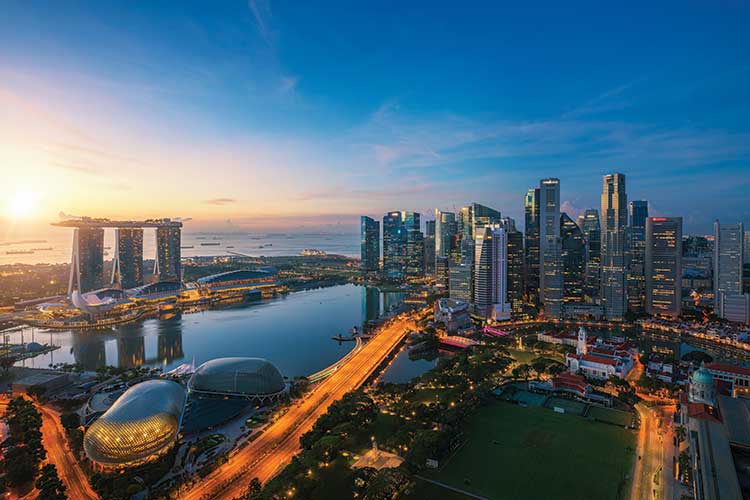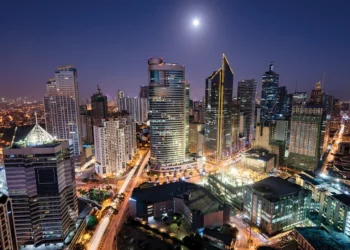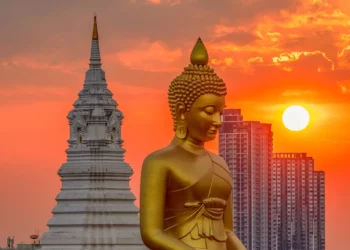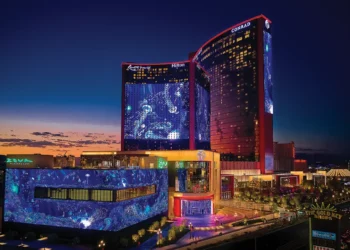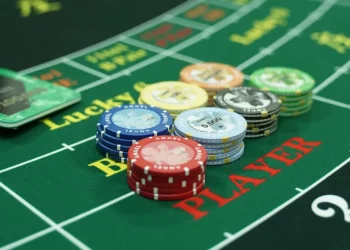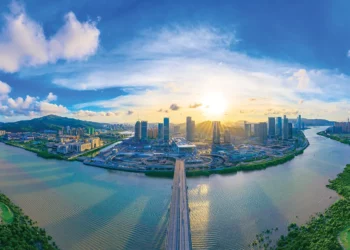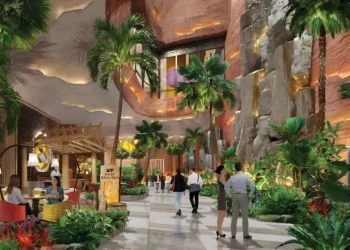Ten years on, Singapore’s integrated resorts push the non-gaming envelope while leaving casino revenue on the table.
From the moment Resorts World Sentosa (RWS) dealt its first cards on 14 February 2010, Singapore’s integrated resorts have set the pace in global gaming. RWS and Marina Bay Sands (MBS) established new benchmarks for IR design and operations, delivering huge profits at breathtaking margins to parent companies Genting Singapore and Las Vegas Sands.
Singapore regulators keep writing the playbook for IR development and oversight that jurisdictions across the globe study and strive to emulate, complete with a compelling case study of how introducing casino gaming can reduce problem gambling.
Singapore’s IRs revamped the city’s image as a tourism destination and even as a place to live and work. In a city already known for conventions, hospitality, shopping and eating, the IRs raised the bar in each segment. A SG$9 billion (US$6.7 billion) expansion agreement struck between the government and the operators last year will enhance the IRs’ signature features and Singapore’s tourism proposition.

The only category where the IRs’ performance doesn’t blow away all rivals is on the gaming floor. Estimated gross gaming revenue was US$6 billion in 2011, a total it has never exceeded; last year, GGR was likely around US$5 billion. The Venetian Macao regularly beats market leader MBS in GGR, and all four Sands China Cotai properties better its per table revenue. (MBS is the LVS corporate champion in revenue per gaming machine).
In one of the richest cities on earth with a visitor mix that includes many of the world’s wealthiest, Singapore’s gross gaming revenue stands out as a missed opportunity – albeit a wholly predictable one.
 “The government of Singapore long viewed the introduction of integrated casino resorts as a tool to grow international visitation – not to make Singapore a gaming destination,” Klebanow Consulting Principal Andrew Klebanow says. “By limiting the number of operators to two and placing constraints on the size of overall gaming space, the government was able to attract only top tier operators with the wherewithal to develop unique multi-billion dollar properties.
“The government of Singapore long viewed the introduction of integrated casino resorts as a tool to grow international visitation – not to make Singapore a gaming destination,” Klebanow Consulting Principal Andrew Klebanow says. “By limiting the number of operators to two and placing constraints on the size of overall gaming space, the government was able to attract only top tier operators with the wherewithal to develop unique multi-billion dollar properties.
“Could the Singapore government have generated greater gaming revenue and garnered more casino tax revenue through a different approach? Yes, but it was not their goal.”
TOURISM CATALYST
“The Integrated Resorts (IRs) were envisaged as large-scale iconic lifestyle destinations that would broaden Singapore’s leisure, entertainment and MICE options and enhance Singapore’s tourism appeal, while contributing to the local economy and creating good jobs for Singaporeans,” the Ministry of Trade and Industry writes in response to questions from Inside Asian Gaming.
“The IRs have had a catalytic effect in galvanizing Singapore’s tourism industry,” the ministry, which includes the Singapore Tourism Board that oversees the IRs along with the Casino Regulatory Authority under the Ministry of Home Affairs, declares. “Marina Bay Sands has been pivotal in transforming the Marina Bay into a dynamic district for work, live and play … Resorts World Sentosa has also played a key role in enlivening Singapore’s tourism landscape, particularly in enhancing the appeal of Singapore’s premier island resort getaway, Sentosa.”
Marina Bay Sands shouts that the Lion City is not your father’s – and not his father’s – Singapore anymore, an architectural expression of the “X factor” Prime Minister Lee Hsien Loong sought when he proposed casino legalization in 2004. Supplanting the Merlion as a city symbol, MBS features a trio of tapering towers linked by the SkyPark, 57 stories above the Singapore River, with the famed infinity pool that’s irresistible for selfies.
Inside architect Moishe Safdie’s fabulous wrapper, MBS is a supersized, remastered edition of Singapore’s greatest hits. The shopping mall showcases luxury brands in a sun-splashed setting that outshines rivals. Last year, MBS debuted Singapore’s largest nightclub, Marquee, with a Ferris wheel and multi-story slide, alongside its Broadway style theater. MBS ups the F&B ante with celebrity chefs such as Wolfgang Puck, Daniel Boulud, Tetsuya Wakuda and local sensation Justin Quek (RWS opened with Joel Roubuchon).
In a city teeming with museums, the ArtScience Museum takes curating to new heights, including the Future World permanent exhibition by Japan’s teamLab ubertechnologists.
ONE-UPMICESHIP
Above all – SkyPark notwithstanding – there’s the 120,000 square meter (1.3 million square foot) Sands Expo and Convention Center, the city’s largest corporate event space, able to accommodate 45,000 delegates.
“They had very strong facilities here before we arrived, but what the government recognized – and this was quite visionary – is that even though they were strong in this area, they could get stronger,” Marina Bay Sands President and CEO George Tanasijevich explains.
Resorts World Sentosa, on the other hand, brought something new to town, Universal Studios, the world class theme park Singapore long sought.
“RWS has long been recognized as a game changer in the region for tourism,” a Genting Singapore spokesperson tells IAG. Singapore recorded an estimated 19 million visitors last year, nearly double the 9.7 million arrivals in 2009. RWS also has a waterpark, aquarium, maritime museum, shopping, dining, convention facilities and six hotels.
At the core of both IRs lies the casino, not just figuratively but literally, the gaming floors buried within each IR.
“The government has tried all kinds of ways to hide casinos,” National University of Singapore Assistant Professor Lee Kah-Wee says. His 2018 book, Las Vegas in Singapore, highlights how the design of Marina Bay Sands reflects Singapore’s national anxieties about gaming.
“We continue to tell ourselves stories about why it is not a casino. We still try hard not to speak the truth.”
The recent expansion deal, which grants both IRs additional gaming machines and options for casino enlargement, drew less reaction from the public than Lee anticipated. He suggests there’s a “conditional normalization” of IRs that still demands caution from stakeholders. “The hot buttons are still there. But they’re careful not to push them.”
IDLING ENGINE
Gaming remains the economic engine of every IR in Asia. For MBS, gaming represents 70% of revenue and, even with nightly hotel rates averaging US$475 at 98% occupancy and a retail mall cash cow, gaming accounts for a slightly larger proportion of profits. Genting Singapore gets about 65% of its revenue from gaming but doesn’t break down profits.

Singapore initially floated enforcing a 50-50 gaming/non-gaming revenue mix. On the Las Vegas Strip about two-thirds of revenue comes from non-gaming sources, but Lee doubts any Asian destination can match that mix.
“It’s really a question of market saturation,” Lee, whose Casino Urbanism project investigates the impact of gaming in Singapore, Manila and Macau, explains. Las Vegas has reached its levels of non-gaming spending because gaming has expanded across the US to saturation levels, he believes. “Until Asia has similar saturation, you’ll never get 50-50.”

Despite the IRs’ dependence on gaming revenue, Singapore authorities remain committed to suppressing it. Singapore’s decision to legalize casinos remains among the most controversial the government has ever taken, multiple sources affirm. Opposition centers on fears that casinos will increase problem gambling and gambling addiction. Along with creating a new term, integrated resort, to describe the casino complex with its vast array of non-gaming facilities, Singapore practices creative ways to discourage gaming.
In addition to creating the much-needed National Council on Problem Gambling – before IRs, Singapore gaming options included horse racing, sports betting, lotteries and even slot machines in so-called “jackpot rooms” within private clubs – authorities banned casino advertising and many forms of marketing, though IRs can trumpet their non-gaming features. Gaming areas are limited to 15,000 square meters with a cap at 2,500 gaming machines.
The Casino Regulatory Authority piled on licensing requirements for junket promoters to the extent that none from Macau applied. RWS works with three small junket promoters, MBS has none, so the IRs overwhelmingly source their own VIPs and hold hundreds of millions of dollars in player debt. In a further departure from Macau, Singapore bans casino shuttle buses.

PAY TO PLAY
Singapore didn’t invent the entry fee for citizens – it was used at some early US regional riverboat casinos and it’s charged only to Koreans at Kangwon Land – but regulators put it at the center of responsible gaming policy. Singapore citizens and permanent residents initially had to pay SG$100 (US$74) entry tax for 24 hours or SG$2,000 annually to enter a casino. The tax rose 50% in April 2019 to SG$150 daily and SG$3,000 annually as part of the expansion deal, despite Singapore’s rate of problem gambling falling from 2.6% in 2011 to 0.9% in 2017.
Responsible gaming expert Kahlil Philander “appreciates the consideration” Singapore gives to preventing gaming disorders but disagrees with its tactics.
“The entry fees are more likely to create harms than benefits, because only the most price sensitive customers will change their visit frequency,” Philander, former director of social responsibility for Canada’s British Columbia Lottery Corporation and now an assistant professor at Washington State University’s School of Hospitality Business Management, says. “This means a greater share of revenue will come from players with problems.”
Philander contends entry fees deter casual players who may visit the casino after shopping, a show or meal at the IR. Singapore Pools, running sports betting and lotteries for the domestic market with a larger gaming turnover than the casinos, reminds customers “to play our games just for a little flutter,” highlighting the British culture Singapore inherited from its colonial past. Yet the National Council on Problem Gambling says the entry tax “is aimed at deterring casual and impulse gambling,” a little flutter that’s precisely the opposite of compulsive gambling.

With authorities squeezing both the lower and high ends of the market, politics may prevent Singapore from ever reaching its gaming potential; it would hardly be the only destination to suffer that fate. Given Singapore’s demographics and visitor profile, gaming revenue looms as a missed opportunity, albeit with some dissenting opinions.
“The missed opportunity is all the years before 2010 that Singapore was without it,” former LVS President William Weidner, part of the team that won the license, says of MBS. “Far from a lost opportunity, it represents a sustainable economic boon that has been successful beyond all expectations and brought the beautiful but static skyline of Singapore to life for both visitors and Singaporeans alike.”
And that’s just what Singapore bet on.
Pressing their bets
Last April, Singapore and its integrated resort operators announced an expansion plan with each IR to invest SG$4.5 billion (US$3.3 billion) – more than half of their initial investments. The duopoly has been extended to 2030 with casino taxes rising and gaming expansion an apparent afterthought.
Genting Singapore’s Resorts World Sentosa will increase its floor area by some 50%, expanding attractions Universal Studios and S.E.A. Aquarium – to become Singapore Oceanarium – as well as revamping its theater into the Adventure Dining Playhouse, overhauling its shoreline as part of Singapore’s broader Greater Southern Waterfront Strategy and adding two new hotels with up to 1,100 rooms. Work is expected to begin later this year.
Las Vegas Sands will add a 15,000 seat indoor arena to Marina Bay Sands, along with new convention areas and around 1,000 hotel suites in a new tower with its own rooftop pool. The new tower will rise from a 33,000 square meter (355,000 square foot) plot that LVS has long coveted, across the street from the current three towers.

“We faced some constraints here in existing Marina Bay Sands because of the success that we had,” MBS President and CEO George Tanasijevich says. The new arena, an alternative to 30-year-old Singapore Indoor Stadium, will make the city a more attractive destination for touring acts, Tanasijevich adds, as well as “feature opportunities for corporate hospitality, which are largely absent” from the market.
On the casino side, MBS can add 2,000 square meters of gaming area and up to 1,000 gaming machines – at present, each IR is allowed 15,000 square meters of gaming area and 2,500 machines. RWS can add up to 500 square meters of gaming area and 800 machines.
According to the government, the IRs say any added gaming facilities will aim at “higher tier, non-mass market players, who are mainly tourists.” Authorities also emphasize that if the operators add all their permitted gaming floor space, the IRs’ percentage of gaming area will fall from 3% to 2.3%.
Expansion comes at a price beyond capital investment. In addition to entry taxes for residents rising 50% within 24 hours of the expansion announcement, gaming tax rates will increase on 1 March 2022 by three percentage points to 8% for VIP revenue and 18% for mass revenue, cutting into margins now among the industry’s highest. Category tax rates will increase an additional four percentage points for a casino where VIP revenue exceeds SG$2.4 billion or mass GGR exceeding SG$3.1 billion, well above the IRs’ current figures.
Stock analysts gave the expansion scheme mixed reviews, but consultant Andrew Klebanow sees a bigger picture.

“What RWS and LVS get in return for their new round of capital investment is another 12 years of market stability, operating in a duopoly,” he says. “Besides, both operators were capacity constrained, not so much for gaming space but lodging keys. They needed more lodging space not only to service gaming customers but to serve more customers willing to spend over SG$450 a night for a room.”
“The expansion deal is positive for both regulators and operators, in that it will further secure and maintain Singapore’s competitive advantages over current and prospective rivals, such as the Philippines, South Korea, and more importantly, Japan in the near future,” says The Innovation Group Senior Vice President International Operations Planning and Analysis Michael Zhu. “Without the expansion plan boosting attractions, offerings and services, the properties and the market would likely see other competitors in the region catching up and eventually outrunning Singapore.”






